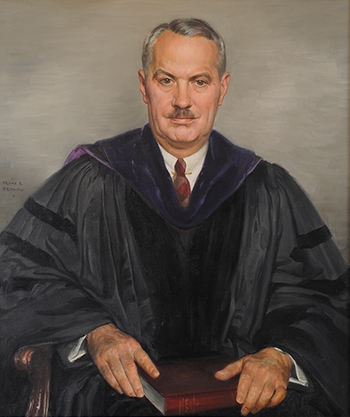Carter Davidson
The 13th president of Union College
Term:
Academic credentials:
Carter Davidson served as president of Union for nearly 19 years, a term exceeded only by Eliphalet Nott's unbeatable 62 years, and Charles Alexander Richmond's nearly 20. Like Nott's, Davidson's tenure was to prove profound in its influence on the history of the College for its beginning coincided with the end of World War II, and its length with the course of the revolution in higher education that came about as a consequence of that war. When Davidson assumed office, Union was nominally a college of 800 students. When he left, its enrollment had risen to 1,307. The campus he inherited had seen no new academic building since 1930. Under his leadership dormitories and a library were built, and two more dormitories and two major classroom buildings, planned under his administration, were erected shortly after his departure. The mark he left on Union is indelible.
During his ten years as president of Knox College in Galesburg, Illinois, Davidson made a favorable impression on many, including some Union College trustees; consequently, when Dixon Ryan Fox died suddenly in January 1945, Davidson was chosen to succeed him. He arrived in Schenectady on May 1, 1945, and was inaugurated as president on May 11.
Within six months, enrollment at the College had been doubled by the influx of returning veterans and it continued to rise until 1950. Between his arrival and the opening of classes in early September, Davidson recruited 50 new faculty members, most of them through his own searches and interviews. He also had to deal with the problem of housing the returning veterans and faculty. Through it all, Davidson moved with cautious efficiency and the College survived the wrenching changes with few scars.
During Davidson's first ten years at Union, the endowment rose from $5.0 million to $19.5 million. He oversaw the completion of two major buildings—West College Dormitory and Dining Hall (1950) and the Memorial Field House (1955)—and several smaller projects. He proved a successful fundraiser on his own for specific projects like the field house and Schaffer Library (1961). By the time his term ended he had also built Richmond House, and conceived plans for the Humanities and Social Sciences Building (1967) as well as the dormitories eventually named Fox House and Davidson House (1967).
Davidson recruited faculty members with strong academic credentials, insisting on doctorates and teaching experience at other institutions. He claimed with pride that he had chosen some of the best faculty in America, and he was reluctant to impose his own pedagogical views on them, though he could do so if he felt it was important enough. He abolished the long-standing and highly successful B.S. in physics and B.S. in chemistry because he believed they were too narrowly professional for Union.
Davidson took the initiative in adding a Department of Sociology and regular courses in art. Returning in 1959 from an international conference convinced that Union's curriculum needed to become more worldly, he quickly instituted courses in East Asian and Africa, and a rudimentary language laboratory.
From the "Encyclopedia of Union College History"
![]()
